
 Koninklijke Marine Destroyers: Onderzeebootjager Typ 47A, Built 1950-55.
Koninklijke Marine Destroyers: Onderzeebootjager Typ 47A, Built 1950-55.HNLMS Holland, Zeeland, Noord-Brabant, Gelderland (D808-811) service 1954-79
Holland class destroyers: The postwar years saw a renaissance of the crippled, but proud Netherlands Navy, fighting on all fronts during WW2 against the axis. The two prewar cruisers of the De Ryter class were completed in 1953, an aircraft carrier was soon obtained, HNLMS Karel Doorman, and to escort this first Dutch carrier battle group, the Navy ordered eight destroyers in two tranches. The Holland were the first of these. They incarnated this transition between conventional destroyers and future missiles destroyers, with a classic silhouette, artillery and AA, ASW rocket launchers, but excellent radars and sonars. Apart Holland sold to Peru to go with its former cruisers in 1978, the three remainder were scrapped. They inherited names of former cruisers: Holland, Noord Brabant, Zeeland, Gelderland. Next stop, the Friesland class. #netherlands #coldwar #destroyers #holland #gelderland #noordbrabant #zeeland
Development
The Royal Netherlands Navy lost many surface vessels and submarines during the war, and became dependent of the Royal Navy for its sustenance, based around its own remaining light cruisers HNLMS Tromp and Jacob van Heemskerck. The naval staff had a reunion at The Hague in 1945 to discuss the challenge of rebuilding the Royal Netherlands Navy, still possessing at the time its colonial Empire. The same staff was composed of veterans and this experience in the Second World War help to draw realistic plans for a future navy, and to determine what classes were needed. The only obstacle was of course budgetary, after the hardships of German occupation. It was agreed still defend the Dutch East Indies by potential new foreign invaders and to rebuilt at home destroyed infrastructure, which was linked to the economy’s shape and as fast it can rebuild.
The design of new ships nevertheless started in 1946 already, with preparatory work for completing the De Ruyter class, and to laid down new destroyers, prioritized in this rebuilding effort, as they made the bedrock of Dutch wartime operations already, showing their capabilities. The last used, the Admiralen and Tjerk Hiddes classes were inspired by British designs, but with the new NATO context (since 1949), the Navy chosed to concentrate on Anti-Submarine Warfare.
Dutch naval experts wanted the Royal Netherlands Navy to invest in submarine destroyers as it was believed they would play major role in a future war, especially against the USSR, which itselfbebt on submarines (the Project 613 reveal only confirmed these plans. It was very much base on the logical evolution of the role of submarines and their successes in the Second World War (The NL were fully involved in the battle of the Atlantic). They recommended these destroyer’s equipements and for what tactics they might be used to successfully. Base requirements were thus set by the KN Marine for what was called the “1947-class destroyers“. However some in the navy argues they also needed to be protected against radioactivity (NBC) and to perform still coastal bombardments if needed. But air cover was never a priority. This had to be covered by the new cruisers. Surface torpedo attacks was not considered either, as a role devoted to the cruisers and new carrier, which shown during the war how capable they were to eliminate surface asset.
The Onderzeebootjager Typ 47A and 1949 plan
In 1948, it was decided to order six of twelve planned destroyers planned on this 1947 design or “onderzeebootjager Typ 47A”. The name could be translated as “sub-hunters” and in now way indicate their destroyer status, underlying well their nature. These ships innovated at many levels, they were the first with twin dual purpose turrets, first with ASW rocket launchers, first with sophisticated radars and sonars (A department that was brand new and built almost from scratch in between). Dutch electronics would soon gained a world reputation of excellence. Some older systems borrowed from WW2 Royal Navy inventiry as the “huff duff” installed on top of their foremast and the sonar types derived from WW2 British models as well. All thse additions raised concerns about stability, leading to adopt aluminium for their superstrctures, somethig quite new at the time, and soon adopted worldwide, but which came with its own set of issues, notably propention to fire. The NBC system that was to be installed was also brand new and a whole sealing and air conditioning system had to be designed from scratch, including an external washing hose system.
Construction of the Holland class
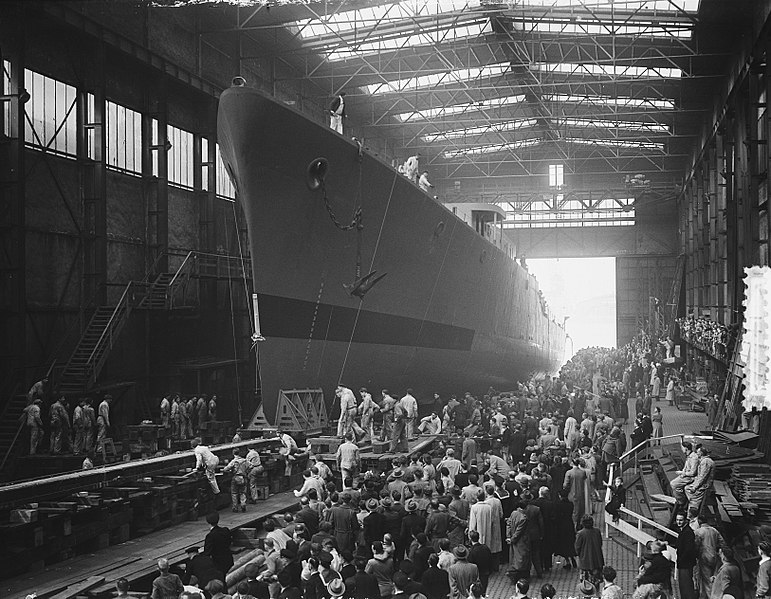
The four Holland-class destroyers would be ordered to three different shipyards.
-HNLMS Holland was built at Rotterdamsche Droogdok Maatschappij
-HNLMS Gelderland built by Wilton-Fijenoord
-HNLMS Noord-Brabant and HNLMS Zeeland were built at Koninklijke Maatschappij de Schelde.
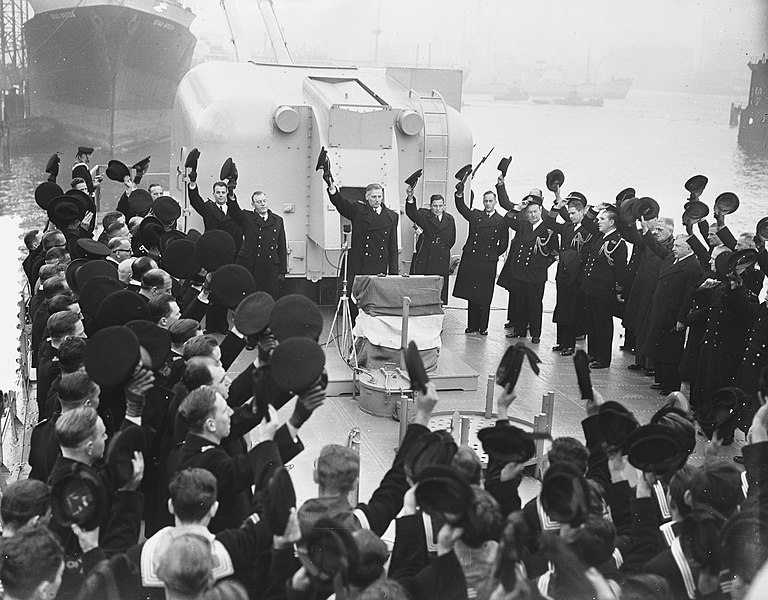
Commission ceremony, HtMs Holland
Their construction took longer than expected: They were the first destroyers designed after the war, experience needed to be rebuilt aft six or even eight years of shut down offices and stopped R&D. In addition a lot of catching up were needed as they has been many technological advancements, and implement these were another phase. They were all delayed as the blueprints were generated from 1948 to 1950 when eventually approved, and materials gathered for ships that shared nothing with the previous destroyers. Their new aluminium structure and radars posed many challenges. Delays were also indicative to a largely budget strapped situation which crippled the Dutch navy. Most financed were funneled through the maintenance on the old and outdated ships still in service for basic needs, and rebuilding a ravage infrastructure.
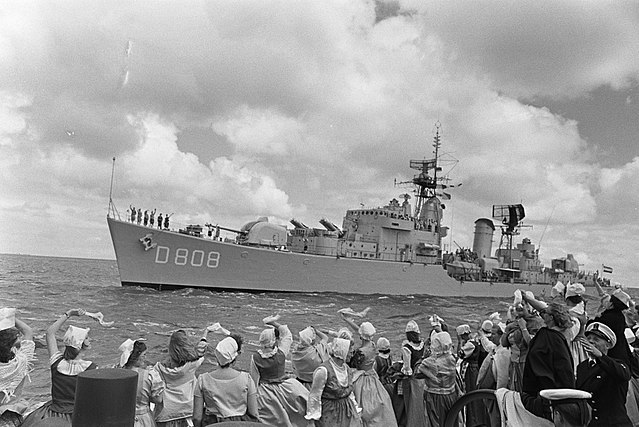
HtMs Holland off Chatham, cheered by a crowd in traditional costumes.
Delays and complexity also raised cost way above the early estimates and to save costs and time, they were eventually provided with WW2 equipment, notably what was built in the country under the occupation for the Kriegsmarine. Two more were planned of this design, but bdugerary constraints limited the class to just two, before a new one for the next batch was designed. These two ships were postponed, until cancelled as the new Friesland class were planned. HNMLS Holland was at last in service from 30 December 1954, followed by Zeeland, Noord-Brabant and Gelderland, the last in 1955. They served until the 1970s. Eight of the next Friesland class, cheaper and quicker to built followed soon, and nearly all went to the Peruvian Navy as part of the 1973 deal.
It should be precised there, that the KNL Marine was not “naked” in terms of destroyers before these two new classes arrived in 1953-57: Were transferred in 1945 the Banckert class (HtMs Banckert, Evertsen, Van Galen, Piet Hein, Tjerk Hiddes, Kortenaer, Marnix) and in 1950 under MDAP, were also transferred the Van Amstel class, former Escort destroyers of the Cannon class (Van Amstel, De Bitter, Van Ejwick, Dubois, De Zeeuw, and Van Zjill).
Design of the Onderzeebootjager Typ 47A
Hull and general design
These first destroyers built without torpedoes felt odd to some old salts the Navy, but again, their denomination clearly pointed out a pure ASW nature, with convoy defence second, and shore bombardment third. Specifications in 1947 led to have initial plans approved in 1948, but two more years were needed to generate all details blueprints, and so the yard had to wait, gearing up for their construction. Indeed, they were asked to use an aluminium alloy to reduce weight, as well as using for the first tome electric welding throughout, which also spared weight.
They were a mix of old and new. First off, their classic “tooth brush” style hull with a long forecastle and two funnels recalled WW2 destroyers, but they innovated by their transom stern. In addition to the lack of portholes the superstrcutures were well developed. It is argued that at least part of the former Tjerk Hiddes class was retaken to gain time in designing the internal accomodations, although they had to meet the demands of new armaments, storage, more electrical power than any previous destroyer for the radars, and NBC protection, with full sealing.
Powerplant
This was one of the “old school” aspects of the design to gain time, a steam turbine machinery ordered even before the war, intended for the cancelled Gerard Callenburgh-class destroyers, hidden during the German occupation. They had been built by Werkspoor and joined to four spare boilers. In addition to these lateb 1930s design equipments, the ships came out with a classic machinery layout, with alternating boiler rooms and turbine rooms to restrain flooding and preserve some energy.
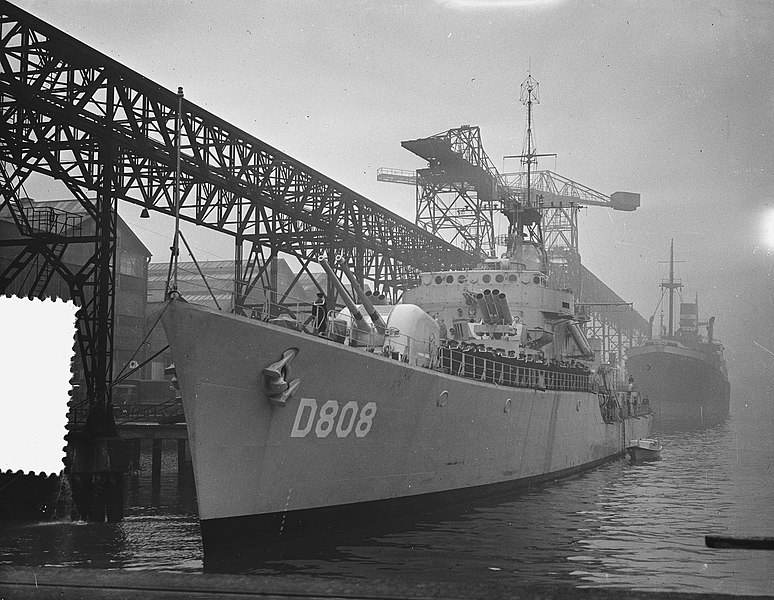
Fitting out in Rotterdam, HrMs Holland
Armament
Initially the Typ 47A planned British 4.5 inch twin Mk 6 mountings fore and aft. But as the design progressed, they were rejected due to complexity and manpower requirements (19 each) as well as dependence on hydraulics for operation, the staff wanted an all-electric solution which was believed less sensitive and precise.
As far the armament went, this was new: The ship ditched previous single shielded artillery for two brand enw twin Bofors 120 mm guns, capable of 45 rounds per minute. A joint-venture between Netherlands and Sweden like for the De Ruyter class cruisers and Swedish new destroyers, these were modern mounting, automated, fully stabilised with radar control.
Main 2×2 Bofors 120 mm/50
The Bofors 120 mm (4.7 in) Naval Automatic Gun L/50 or model 1950 was the first heavy twin-barreled fully automatic dual purpose naval gun turret system by Bofors. It was worked out already during WW2 as a private venture, and was relaiunched after a request by the Netherlands Navy in 1948. Development really went to fruition in 1951-54. The Swedish navy also adopted it.
In all, 720 rounds were stored per mounting in the hull below.
⚙ specifications Bofors 120 mm/50 |
|
| Weight | 67,000 kg (148,000 lb) |
| Elevation | -9°/+85°, 25°/s, traverse 360 at 22°/sec. |
| Loading system | Automatic extraction with integrated autoloader |
| Muzzle velocity | 835–850 m/s (2,740–2,790 ft/s) |
| Range | c12,000m |
| Guidance | Fire Control Radar |
| Crew | 2 (control) |
| Round | 120 × 835 mm R 23.35 – 23.5 kg |
| Rate of Fire | 2× 42 rounds/min |
AA: 6x Bofors 40 mm Automatic Gun L/70
The close-range anti-aircraft armament started with six Bofors, all single. At the end of their career it was reduced to just one single Bofors 40 mm gun to regain stability.
The L/70 was a longer barrel, dual feed variant of the famous wartime L/60 classic Bofors, probably the best naval AA gun of the war. They were installed on the wings amidships between funnels and the last pair aft, on the superstructure.
Specs: 0.96 kg (2.1 lb) 40 × 365 mm R shell. 240, 300, 330 rpm, Mv 1,000 m/s (3,300 ft/s) range 12,500 m (41,000 ft), fed by 16–26 round hoppe
ASW
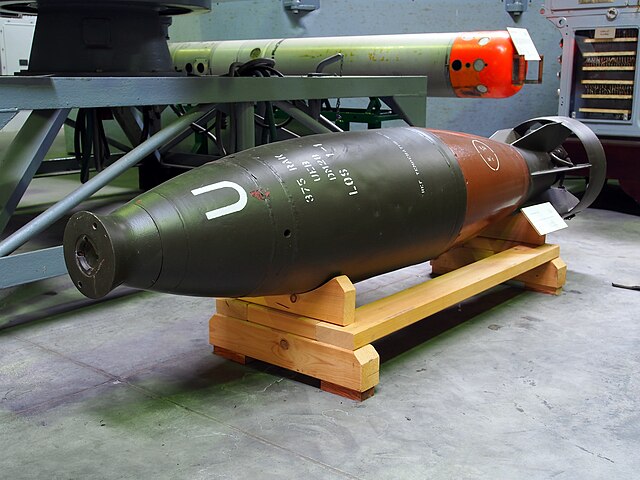
The Anti-submarine weaponry comprised two quadruple Bofors 357 mm anti-submarine mortars placed in superfiring ‘B’ forward of the bridge, where another twin turret coukld have been. They offered a wide fire arc and could fire eight heavy depht charge, fused at a distance. These 14.8 in rockets used solid fuel, and had a max range of 3,625 m (11,893 ft), carrying a heavy Warhead High explosive, exploding using an Acoustic Proximity Fuse. A pupular model it was also used by Sweden and France under licence and others navies.
This was completed by two depht charge racks at the stern.
Missiles
The Royal Netherlands Navy considered replacing the after 120 mm turret with a guided missile system in the late 1950s but this project was cancelled. It wouylkd have been a single launcher aft, US SM-1 Standard.
Sensors
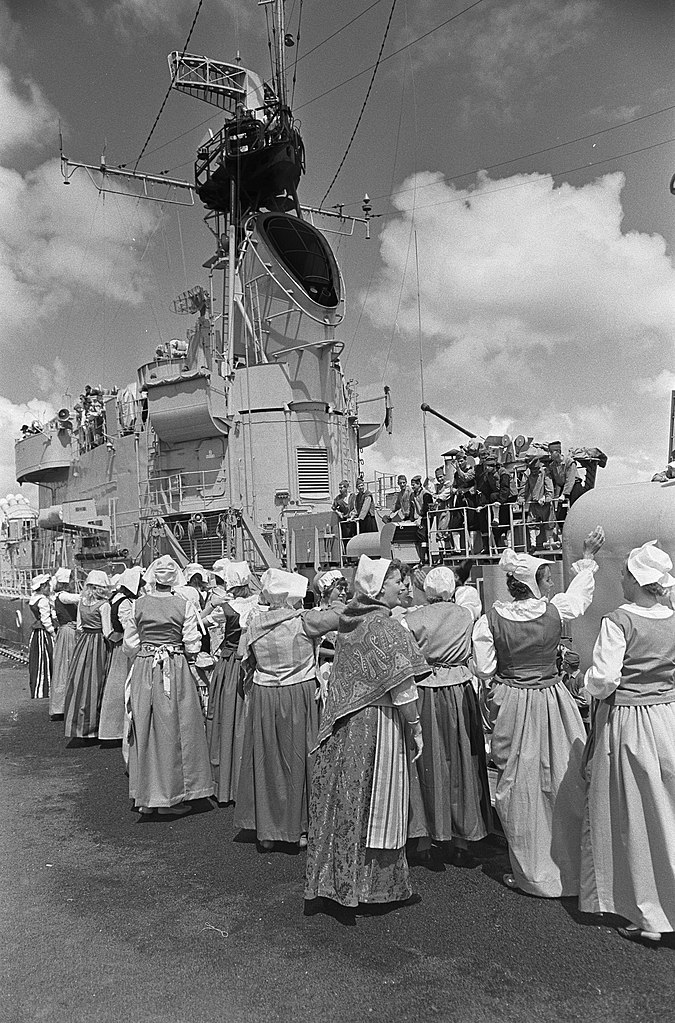
The radars aboard were designed by Hollandse Signaal Apparaten. The suite comprised the following:
-The ZW-01 surface warning radar
-The DA-02 medium range surveillance
-LW-02 long range surveillance.
-GA-03 Fire control radars (main gun)
-KA-01 radars (AA Bofors 40 mm).
-AE-1N P hull Sonars and CWE-10, but no towed sonar.

⚙ specifications |
|
| Displacement | 2,150 long tons (2,185 t) standard, 2,600 long tons (2,642 t) full load |
| Dimensions | 113.1 x 11.4 x 5.1m (371 ft 1 in x 37 ft 5 in x 16 ft 9 in) |
| Propulsion | 2 shaft geared turbines, 2 boilers, 45,000 hp (33,556 kW) |
| Speed | 32 knots (37 mph; 59 km/h) |
| Range | 4,000 nmi (7,400 km) at 18 kn (33 km/h) |
| Armament | 2×2 Bofors 120 mm, 1× 40 mm Bofors, 2×4 Bofors 375 mm ASWR, 2 DCR |
| Sensors | ZW-01, DA-02, LW-02, GA-03, KA-01 radars, PAE-1N+ CWE-10 sonars |
| Crew | 247 |
Read More/Src
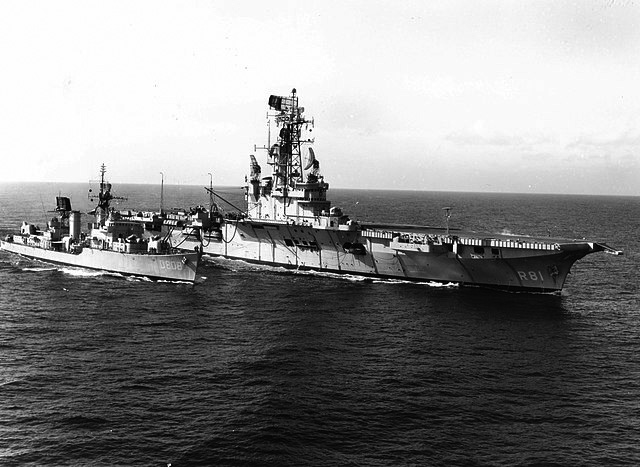
Books
Jordan, John (2016), Warship 2016. Conway, London
Conways all the world’s fighting ships 1947-90
Hank Visser, The Netherlands type 47A destroyer in Warship 2016 Conway’s Maritime Press pp182-185
Amstel, W.H.E. van (1991). De schepen van de Koninklijke Marine vanaf 1945. Alkmaar: De Alk.
Brobbel, Henk (2008). Hr. Ms. Holland: de parel van het eskader. Soest: Boekscout VOF.
Moens, J.; Muller, W.; Bernhard, R. (1970). D810: Hr.Ms. Noord-Brabant.
Mark, Chris (2005). Onderzeebootjagers van de Holland- en Friesland-klasse. Amsterdam: Stichting Vrienden van de Koninklijke Marine.
Schoonoord, D.C.L. (2012). Pugno Pro Patria: De Koninklijke Marine tijdens de Koude Oorlog. Van Wijnen-Franeker.
Gerretse, K.H.L.; Wijn, J.J.A. (1993). Drie-cylinders duiken dieper: de onderzeeboten van de dolfijn-klasse van de Koninklijke Marine. Amsterdam.
Links
maritiemnederland.com/ onderzeeboten
evolution of design 47A shipbucket.com
marineschepen.nl/
marineschepen.nl/
http://www.navyinside.nl/ onderzeebootjagers
seaforces.org/ Holland-class.htm
en.wikipedia.org/ Holland-class_destroyer
commons.wikimedia.org photos
 Holland D808
Holland D808
Hr.Ms. Holland D808 was laid down at RDM (Rotterdamsche Droogdok Maatschappij) Rotterdam on 21 April 1950, launched on 11 April 1953 and completed on 31 December 1954. After working out the crew, weapons and sensors qualifications, she departed for her fisrt deployment in 1955, a long cruise around Africa via Suez Canal and Good Hope. Once home, she was put into reserve, or “conservation” until 1962. Nothing of note for 1962-65 but that year, 1965, she was collided with the Danish ship MV Mayumba off Texel. Nothing for 1966-67? By January 13, 1968, she was assigned to STANAVFORLANT Portland for her NATO stand guard contribution. In 1969 she took part in the fleet review at Spithead altogether with her sisters Zeeland, Noord Brabant, but also the the cruiser De Ruyter, frigates Van Nes and Evertsen. Later this year she took part in NATO Razor Sharp and Northern Merger, Save Pass in 1974.
In July 1976, she crossed the Atlantic to NyC with the frigates Tromp, Van Nes, Van Galen, Zeeland, Dolfijn, Poolster, for the US bicentennial. She was decommissioned in 1978, sold to the Peruvian Navy. Under her new flag she re-entered service by January 2, 1978 as Garcia y Garcia and eventually decommissioned in 1986, later sold for scrap. She had been proposed proposed for preservation to the NL, which declined.
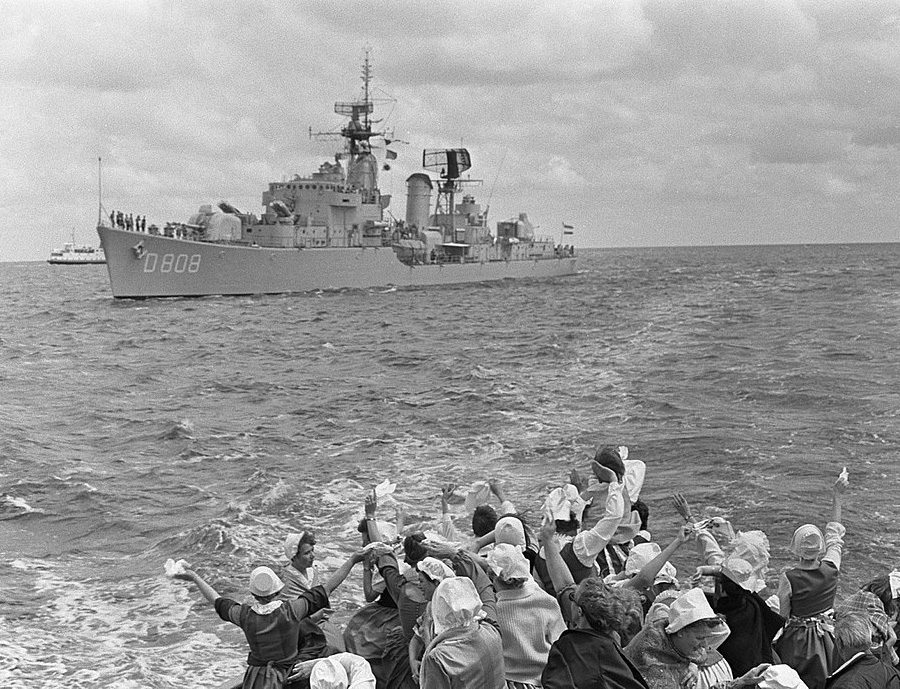
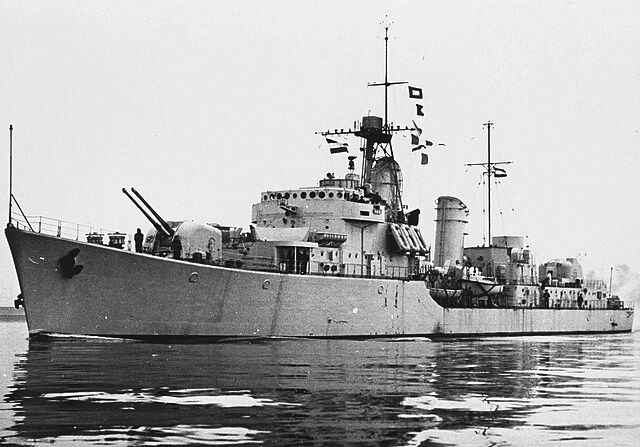

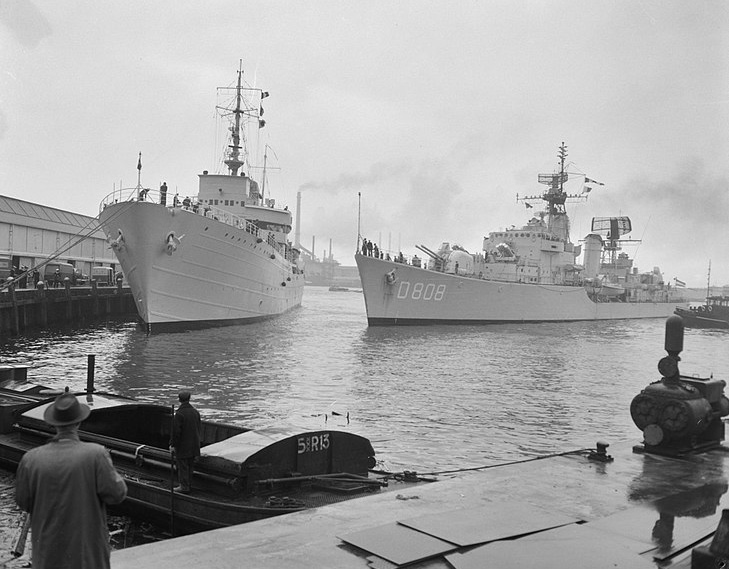
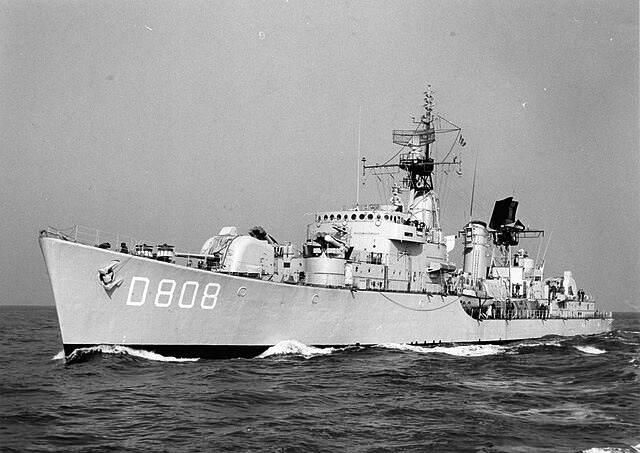
 Zeeland D809
Zeeland D809
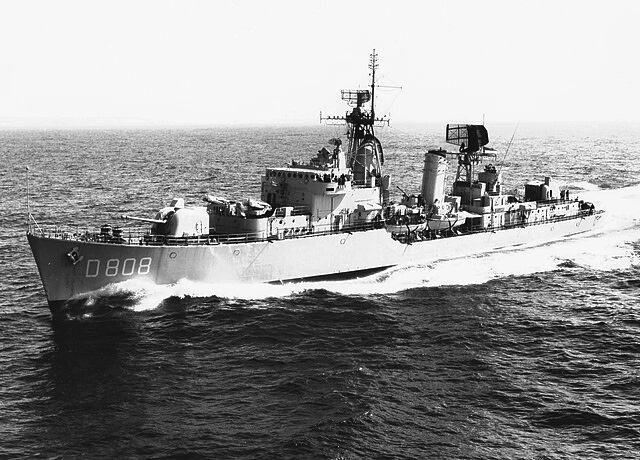
Hr.Ms. Zeeland (D809) was laid down at KM (Koninklijke Maatschappij) de Schelde in Vlissingen on 21 January 1951. She was launched on 27 June 1953 and completed, commissioned on 1 March 1955. After working out her crew she made her shakedown cruise across the North Sea, and stopp ar Portsmouth in 1955. In early 1956 she took part in NATO exercises Grande Chase and Cut Lose. In July she sailed with Friesland and escorting De Zeven Provincien to Leningrad, a first since 1914. They also visited Kronstadt and were officially welcomed by Soviet authorities.Back home she was placed in reserve with a skeleton guard crew from 1956 to 1962.
Nothing to note for 1963-65 after reactivation. In 1966 she took part in NATO exercise Silent Rain and the next year Perfect Play. In 1968 she took part in Silver Tower and started her tout of duty with STANAVFORLANT. In 1969 also she took part in Exercise Razor Sharp and Peace Keeper.
Later that year she was at the Spithead review for the Queen’s jubilee, alongside her sisters Holland and Noord Brabant, escorting Ruyter. Nothing for 1970-75.
In July 1976 she departed with her sister Holland and the frigates Tromp, Van Nes, Van Galen (see the full squadron above) for a visit in New York City, as part of the multinational fleet coming to the USA to celebrate the city’s bicentenary. New York was indeed funded at first as Neu Amsterdam. On September 29, 1979, she was decommissioned, sold for BU to a company in Bilbao, Northern Spain.
 Noord-Brabant D810
Noord-Brabant D810
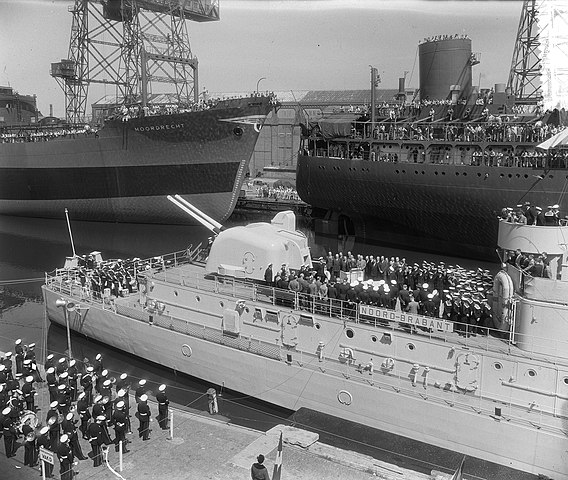
HrMs Noord Brabant at Vlissingen, showing her aft section
Hr.Ms. Noord-Brabant (D810) was laid down at KM de Schelde on 1 March 1951, launched on 28 November 1953 and commissioned on 1 June 1955. No records. On January 9, 1974, whilke underway on the Western Scheldt she collided woth the British bulk carrier “Tacoma City” which tried to avoid a buoy at the last minute but overshot and rammed Noord-Brabant amidships. There was a gash of 3.5 meters, and the collission killed two sailors. She was still able to sail on her won power to the Schelde’s ship repair yard, but examiners concluded she was so damaged at this point that a costly rebuilt was not worth the cost due to her career mostly behinf her. She was thus decommissioned soon after, and sold for BU in 1977.
 Gelderland D811
Gelderland D811
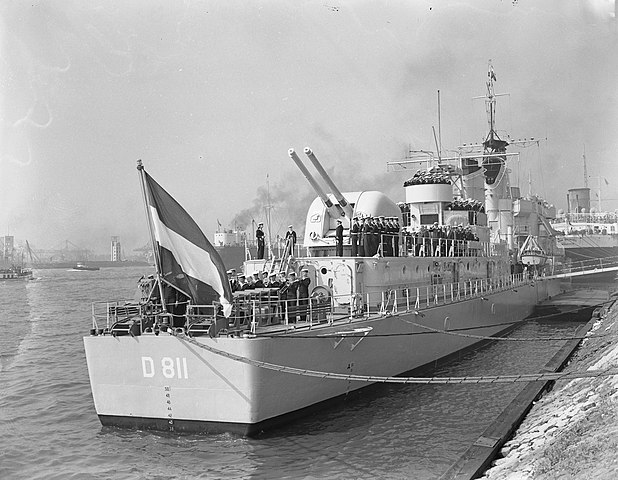
HtMs Gelderland aft section, Rotterdam
Hr.Ms. Gelderland D811 was laid down at Wilton-Fijenoord in Schiedam on 10 March 1951. She was launched on 19 September 1953 and commissioned on 17 August 1955. Later that year she made her shakedown cruise to Lisbon, portugal. Upon return, she had fixes and later completed qualifications. In 1958 she took part in Fleet Week. In 1959 she visited New York for the 350th anniversary of Henry Hudson’s arrival in America. In 1960 she sailed to Morocco to provide relief after the earthquake of Agadir. Back home she served in 1961-63 but was deactivated from 1964 to 1969. No records for 1970-73. The latter year she was decommissioned but transferred to the Technical Training Royal Navy as instruction ship, berthed at Marine Establishment Amsterdam. She had no weapons left, both turrets and the ASRWL were removed. She served as instruction vessel until 1988, then striucken by the Navy and sold to Zaandam, BU in 1993.

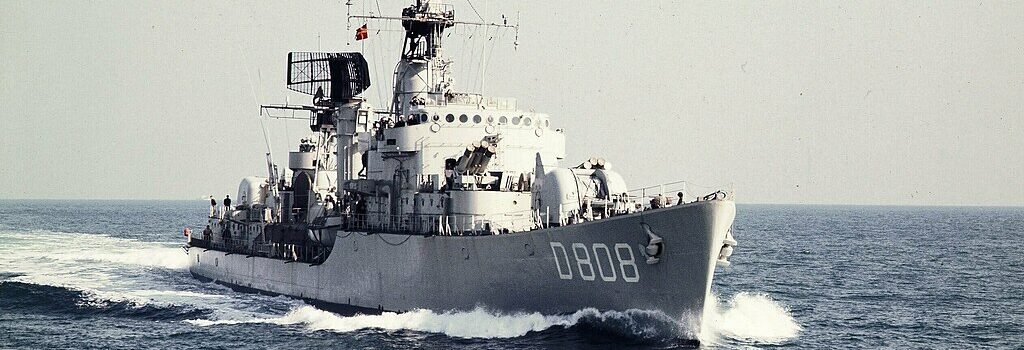
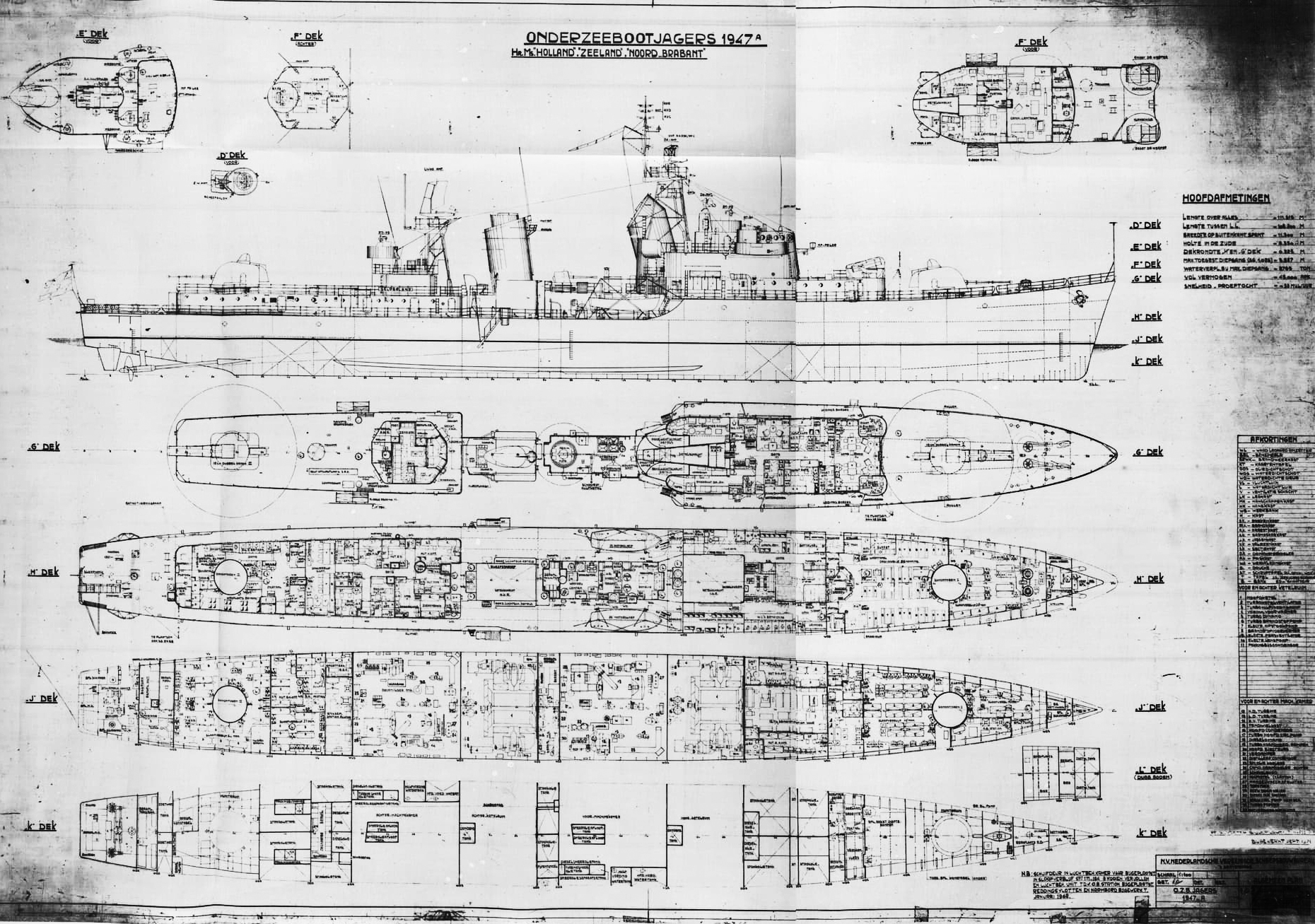
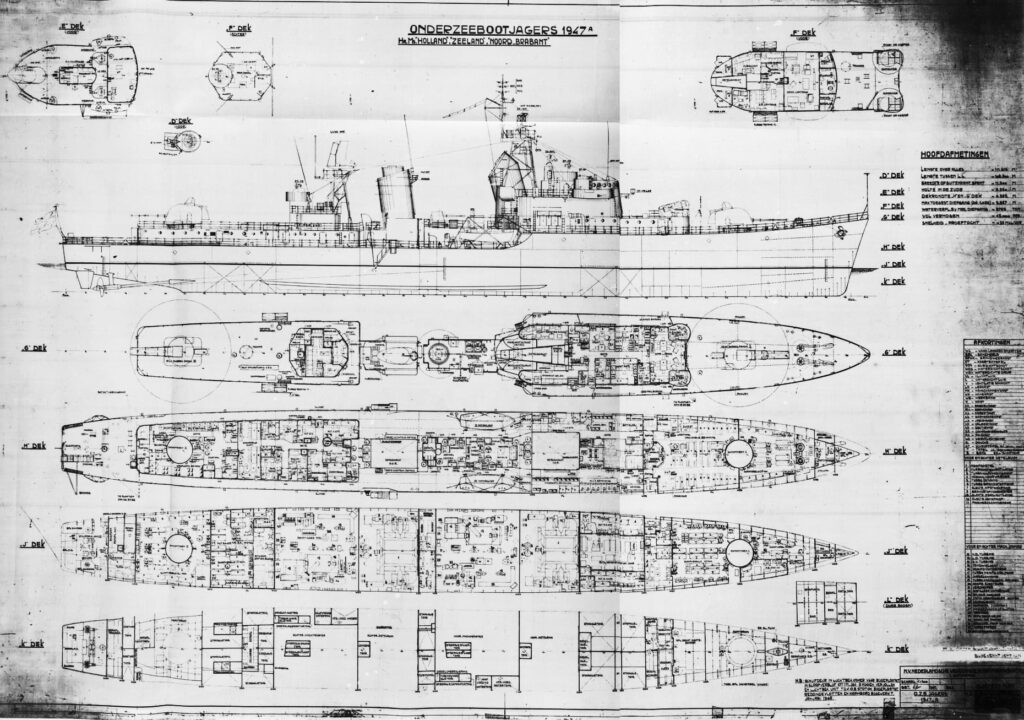
 Latest Facebook Entry -
Latest Facebook Entry -  X(Tweeter) Naval Encyclopedia's deck archive
X(Tweeter) Naval Encyclopedia's deck archive Instagram (@navalencyc)
Instagram (@navalencyc)





 French Navy
French Navy Royal Navy
Royal Navy Russian Navy
Russian Navy Armada Espanola
Armada Espanola Austrian Navy
Austrian Navy K.u.K. Kriegsmarine
K.u.K. Kriegsmarine Dansk Marine
Dansk Marine Nautiko Hellenon
Nautiko Hellenon Koninklije Marine 1870
Koninklije Marine 1870 Marinha do Brasil
Marinha do Brasil Osmanlı Donanması
Osmanlı Donanması Marina Do Peru
Marina Do Peru Marinha do Portugal
Marinha do Portugal Regia Marina 1870
Regia Marina 1870 Nihhon Kaigun 1870
Nihhon Kaigun 1870 Preußische Marine 1870
Preußische Marine 1870 Russkiy Flot 1870
Russkiy Flot 1870 Svenska marinen
Svenska marinen Søværnet
Søværnet Union Navy
Union Navy Confederate Navy
Confederate Navy Armada de Argentina
Armada de Argentina Imperial Chinese Navy
Imperial Chinese Navy Marinha do Portugal
Marinha do Portugal Mexico
Mexico Kaiserliche Marine
Kaiserliche Marine 1898 US Navy
1898 US Navy Sovietskiy Flot
Sovietskiy Flot Royal Canadian Navy
Royal Canadian Navy Royal Australian Navy
Royal Australian Navy RNZN Fleet
RNZN Fleet Chinese Navy 1937
Chinese Navy 1937 Kriegsmarine
Kriegsmarine Chilean Navy
Chilean Navy Danish Navy
Danish Navy Finnish Navy
Finnish Navy Hellenic Navy
Hellenic Navy Polish Navy
Polish Navy Romanian Navy
Romanian Navy Turkish Navy
Turkish Navy Royal Yugoslav Navy
Royal Yugoslav Navy Royal Thai Navy
Royal Thai Navy Minor Navies
Minor Navies Albania
Albania Austria
Austria Belgium
Belgium Columbia
Columbia Costa Rica
Costa Rica Cuba
Cuba Czechoslovakia
Czechoslovakia Dominican Republic
Dominican Republic Haiti
Haiti Hungary
Hungary Honduras
Honduras Estonia
Estonia Iceland
Iceland Eire
Eire Equador
Equador Iran
Iran Iraq
Iraq Latvia
Latvia Liberia
Liberia Lithuania
Lithuania Mandchukuo
Mandchukuo Morocco
Morocco Nicaragua
Nicaragua Persia
Persia San Salvador
San Salvador Sarawak
Sarawak Uruguay
Uruguay Venezuela
Venezuela Zanzibar
Zanzibar Warsaw Pact Navies
Warsaw Pact Navies Bulgaria
Bulgaria Hungary
Hungary

 Bundesmarine
Bundesmarine Dutch Navy
Dutch Navy Hellenic Navy
Hellenic Navy Marina Militare
Marina Militare Yugoslav Navy
Yugoslav Navy Chinese Navy
Chinese Navy Indian Navy
Indian Navy Indonesian Navy
Indonesian Navy JMSDF
JMSDF North Korean Navy
North Korean Navy Pakistani Navy
Pakistani Navy Philippines Navy
Philippines Navy ROKN
ROKN Rep. of Singapore Navy
Rep. of Singapore Navy Taiwanese Navy
Taiwanese Navy IDF Navy
IDF Navy Saudi Navy
Saudi Navy Royal New Zealand Navy
Royal New Zealand Navy Egyptian Navy
Egyptian Navy South African Navy
South African Navy






























 Ukrainian Navy
Ukrainian Navy dbodesign
dbodesign